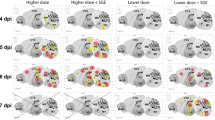Abstract
Thogoto (THO) virus is transmitted from infected to uninfected ticks when co-feeding on uninfected guinea-pigs, even though the guinea-pigs do not develop a detectable viraemia. This form of non-viraemic transmission is potentiated by a factor (s) secreted by the saliva of ticks and hence has been termed saliva-activated transmission (SAT). The synthesis of the SAT factor by the salivary glands of three ixodid tick species was determined by placing uninfected nymphal ticks on guineapigs that were subsequently inoculated with a mixture of THO virus and salivary gland extract (SGE) derived from one of the tick species. SAT factor activity was measured by determining the number of nymphs that acquired THO virus. For the three-host ixodid species,Rhipicephalus appendiculatus andAmblyomma variegatum, maximum enhancement of THO virus transmission was observed when salivary glands were derived from uninfected, female ticks that had fed for a period of 6 or 8 days, respectively. In contrast, when salivary glands were derived form uninfected femaleBoophilus microplus, a one-host ixodid tick species, enhancement of THO virus transmission was observed throughout the tick feeding period. Thus, the natural feeding behaviour of ticks appears to be an important factor in determining the relative importance of these vectors in mediating SAT.
Similar content being viewed by others
References
Alekseev, A. and Chunikhin, S.P., 1990. Exchange of tickborne encephalitis virus betweenIxodes simultaneously feeding on animals with subthreshold levels of viraemia. Med. Parasitol. Parasitol. Dis., 2: 48–50 (in Russian).
Binnington, K.C. and Kemp, D.H., 1980. Role of tick salivary glands in feeding and disease transmission. Adv. Parasitol., 18: 315–319.
Clerx, J.P.M., Fuller, F. and Bishop, D.H.L., 1983. Tick-borne viruses structurally similar to Orthomyoviruses. Virology, 127: 205–219.
Davies, C.R., Jones, L.D. and Nuttall, P.A., 1986. Experimental studies on the transmission cycle of Thogoto virus, a candidate orthomyxovirus, inRhipicephalus appendiculatus. Am. J. Trop. Med. Hyg., 35: 1256–1262.
Hardy, J.L., Houk, E.J., Kramer, L.D. and Reeves, W.C., 1983. Intrinsic factors affecting vector competence of mosquitoes for arboviruses. Annu. Rev. Entomol., 28: 229–262.
Hoogstraal, H., 1979. The epidemiology of tick-borne Crimean-Congo haemorrhagic fever in Asia, Europe and Africa. J. Med. Entomol., 15: 307–417.
Jones, L.D. and Nuttall, P.A., 1989. Non-viraemic transmission of Thogoto virus: influence of time and distance. Trans. R. Soc. Trop. Med. Hyg., 83: 712–714.
Jones, L.D., Davies, C.R., Steele, G.M. and Nuttall, P.A., 1987. A novel mode of arbovirus transmission involving a non-viremic host. Science, 237: 775–777.
Jones, L.D., Davies, C.R., Steele, G.M. and Nuttall, P.A., 1988. The rearing and maintenance of ixodid and argasid ticks in the laboratory. Anim. Technol., 39: 99–106.
Jones, L.D., Hodgson, E. and Nuttall, P.A., 1989. Enhancement of virus transmission by tick salivary glands. J. Gen. Virol., 70: 1895–1898.
Jones, L.D., Davies, C.R., Williams, T., Cory, J. and Nuttall, P.A., 1990. Non-viraemic transmission of Thogoto virus: Vector effeciency ofRhipicephalus appendiculatus andAmblyomma variegatum. Trans. R. Soc. Trop. Med. Hyg., 84: 846–848.
Kemp, D.H., Stone, B.F. and Binnington, K.C., 1982. Tick attachment and feeding: role of the mouthparts, feeding apparatus, salivary gland secretions and host response. In: F.D. Obenchain and R. Galun (Editors), Physiology of Ticks, Pergamon, Oxford, pp. 119–168.
Pegram, R.G., Perry, B.D., Musisi, F.L. and Mwanaumo, B., 1986. Ecology and phenology of ticks in Zambia: Seasonal dynamics on cattle. Exp. Appl. Acarol, 2: 25–45.
Ribeiro, J.M., 1987. Role of saliva in blood-feeding by arthropods. Annu. Rev. Entomol., 32: 463–468.
Sauer, J.R., Suresh, D.M., Schmidt, S.P. and Essenberg, R.C., 1986. Molecular basis for salivary fluid secretion in ixodid ticks. In: J.R. Sauer and J. Alexander Hair (Editors), Morphology, Physiology, and Behavioral Biology of Ticks. Ellis Horwood, Chichester, pp. 55–74.
Shaw, R.D., 1966. Culture of an organophosphorus-resistant strain ofBoophilus microplus (Cannestri) and an assessment of its resistance spectrum. Bull. Entomol. Res., 56: 389–406.
Staunton, D., Nuttall, P.A. and Bishop, D.H.L., 1989. Sequence analyses of Thogoto viral RNA segment 3: Evidence for a distant relationship between an arbovirus and members of the Orthomyxoviridae. J. Gen. Virol. 70: 2811–2817.
Titus, R.G. and Ribeiro, J.M., 1988. Salivary gland lysates from the sandflyLutzomyia longipalpis enhanceLeishmania infectivity. Science, 239: 1306–1308.
Titus, R.G. and Ribeiro, J.M., 1990. The role of vector saliva in transmission of arthropodborne disease. Parasitol. Today, 6: 157–160.
World Health Organisation, 1985. Arthropod-borne and rodent-borne viral diseases. WHO, Geneva, WHO Tech. Rep. Ser., 719, 116 pp.
Author information
Authors and Affiliations
Rights and permissions
About this article
Cite this article
Jones, L.D., Matthewson, M. & Nuttall, P.A. Saliva-activated transmission (SAT) of Thogoto virus: dynamics of SAT factor activity in the salivary glands ofRhipicephalus appendiculatus, Amblyomma variegatum, andBoophilus microplus ticks. Exp Appl Acarol 13, 241–248 (1992). https://doi.org/10.1007/BF01195081
Accepted:
Issue Date:
DOI: https://doi.org/10.1007/BF01195081




